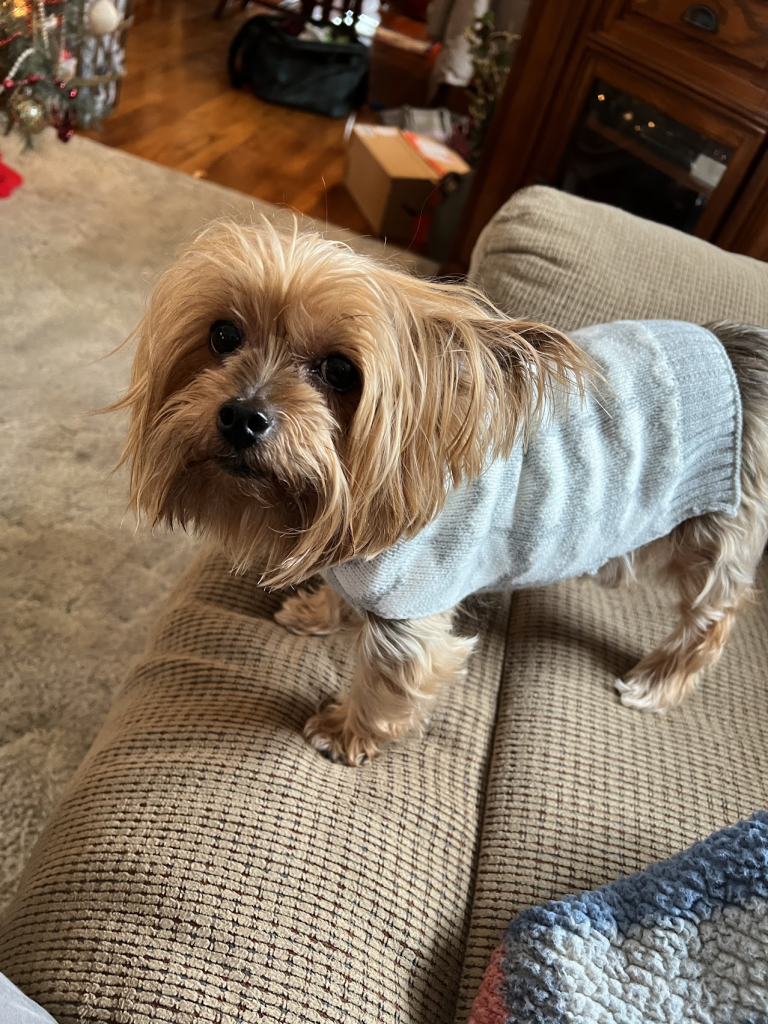Perhaps you’ve heard your Yorkie coughing and it sounds more like hacking. This is very concerning when you hear it for the first time. This sound could be caused by a collapsed trachea.
Table of Contents

Identifying Tracheal Collapse
Health Assessment
A veterinarian performs a thorough physical checkup, including careful palpation of the neck, which may trigger a cough if tracheal collapse is present.
Auscultation is key, with the practitioner listening for abnormal heart sounds and lung noises which might suggest other conditions.
Radiography and Kinetic Imaging
To discern cause of the cough, imaging is vital; standard radiographs are used to examine the heart and signs of respiratory ailments.
For a real-time perspective, fluoroscopy offers moving images, allowing observation of the trachea as it happens, though availability is limited to specialized institutions.
Supplementary Diagnostic Techniques
Bronchoscopy enables direct visual inspection of the airways via a camera-tipped instrument, adding to the diagnostic arsenal.
Collecting cultures can pinpoint concurrent respiratory infections. Severity is graded on a scale from one to four, based on these analyses.
Available Treatments
Medication Strategies
Medications can break the inflammation cycle causing coughs and subsequent worsening of tracheal irritation.
Corticosteroids like prednisolone and fluticasone reduce tracheal swelling and open the air pathways.
Bronchodilators, including albuterol, terbutaline, and theophylline, are utilized to enhance airway clearance and ease the diaphragm’s workload.
Procedural Solutions
When lung collapse is significant and medicinal treatment falls short, surgical options may be considered.
An extraluminal prosthesis or intraluminal stent may support the trachea’s structure. Prior to opting for surgery, it’s imperative to consult with a seasoned surgeon due to possible postoperative complications.
Support Procedures and Habits
Weight management is crucial for obese dogs with tracheal collapse to diminish respiratory strain.
Reduced stress, avoidance of irritants, and switching from a collar to a harness can also mitigate symptoms.
Incorporating controlled leash walking, subject to the dog’s condition, contributes to both weight control and stress alleviation.
Safeguarding Techniques and Management Strategies
Tracheal collapse in dogs is a common ailment, marked by a distinct goose-honking cough and often compounded by inflammatory reactions.
Small to toy breed dogs, especially when overweight or exposed to secondhand smoke, are at higher risk for this condition. He discusses proactive measures like maintaining the dog at an ideal weight and avoiding respiratory irritants to help manage symptoms.
Early recognition and management are key to improving the dog’s quality of life with tracheal collapse.
Minimizing stress and employing gentle exercise such as controlled leash walking can benefit the dog, though it’s critical to avoid over-exertion which can exacerbate the issue.
He also stresses the importance of replacing collars with harnesses to relieve pressure on the dog’s trachea.
When medical intervention is necessary, he outlines a combination of treatments to alleviate symptoms and manage the condition.
Anti-inflammatory medications and bronchodilators can significantly reduce airway inflammation and improve breathing. In more severe cases, specialized surgeries like tracheal stents might be considered in consultation with an experienced surgeon.
Distinguishing Tracheal Collapse from Similar Conditions
Recognizing tracheal collapse in dogs involves differentiating it from other respiratory issues. It often manifests as a distinct, dry cough that sounds like a goose honking, and difficulty breathing. This can lead to a state of panic in the affected dog. Inflamed tracheal rings cause a narrowing of the air passage, exacerbating the dog’s distress.
Small and toy breed dogs, like Pomeranians, Yorkshire Terriers, Poodles, and Chihuahuas, are more commonly affected, especially as they age. Noticeable risk factors include obesity and environmental irritants, with a possibility of an inheritable component relating to tracheal structure.
Veterinary observation typically starts with palpation of the neck, where they may induce the characteristic cough, and auscultation for abnormal heart or lung sounds. Diagnostic imaging, such as X-rays or fluoroscopy, aids in visualizing the trachea. However, their static nature can miss the collapse. A bronchoscope offers a more dynamic view to confirm the diagnosis.
Management of tracheal collapse focuses on relieving the cycle of inflammation and coughing. Calming the distressed dogs is crucial before they receive oxygen or mild sedation. Anti-inflammatory medications are administered, along with bronchodilators to ease air passage and antibiotics for suspected respiratory infections.
For dogs unresponsive to medical treatment, surgical options like extraluminal prostheses or intraluminal stents might be considered. However, surgery requires careful consideration due to the possible complications and necessary postoperative care.
Prevention, though not guaranteed, revolves around maintaining a healthy weight and reducing exposure to respiratory irritants. Adjustable leashes and harnesses are recommended to alleviate neck pressure, and managing environmental factors can contribute to the well-being of dogs predisposed to this condition.